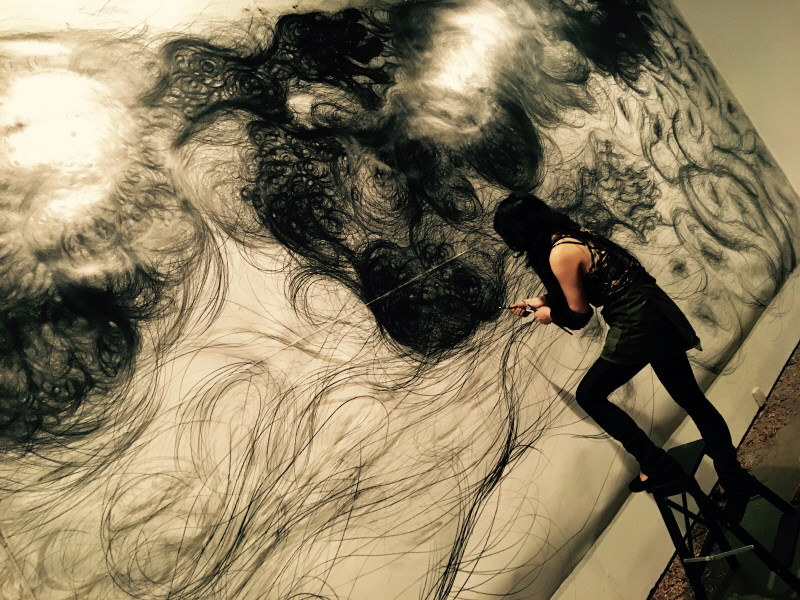Creating a Goddess Myth in a New Era: Artist Park Sobin
By Kang Jennis Hyunsuk
A few years ago, I was fascinated by a pair of unique artworks at the Lee Kang-ha Art Museum in Gwangju’s Yangnim-dong. One of the artworks was a drawing of a dragon and a woman drawn only with black pencils. It expressed the legend of Buseok-sa (부석사), a temple in North Gyeongsang Province. As a person who has seen the beauty of the wooden building, which is now a national treasure with its dragon legend, I was curious about the world of Park So-bin’s artworks, and at last, I was given the chance to conduct an interview with her.
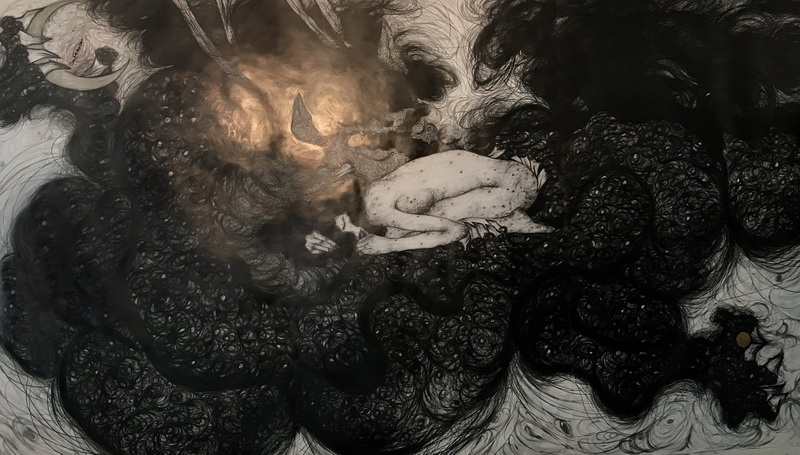
Jennis: It’s nice to have the opportunity to interview you for People in the Arts for the Gwangju News. I saw your artworks at the Lee Kang-ha Art Museum in Yangnim-dong. There I could see only two pieces of your works: One was a self-portrait, which showed the strong touch of thick oil paints, and the other was a pencil drawing of a dragon and a woman. They gave me such a strong impression.
Park Sobin: It makes me happy to know that there are people who remember and support my old artworks. Thank you.
Jennis: I’m curious about your childhood, how did you get interested in art?
Park Sobin: As an only child, drawing became a good friend to me. Thankfully, my parents didn’t raise me to conform to societal expectations. They didn’t ask me what I had to do or what I shouldn’t do as a girl. My father encouraged his daughter who loved drawing. He wanted me to express my thoughts well, so he let me go to a speech academy. Thanks to my parents, who always supported my choices, I was always courageous when I came to a crossroads of choices. I think my father was my first mentor in life.
Jennis: In your self-portraits, I see a human being who has taken off the wrappings of this society’s stereotyped “beautiful woman.” When did you start drawing your portraits? And I wonder what you are trying to say through the intense gaze of the self-portrait.
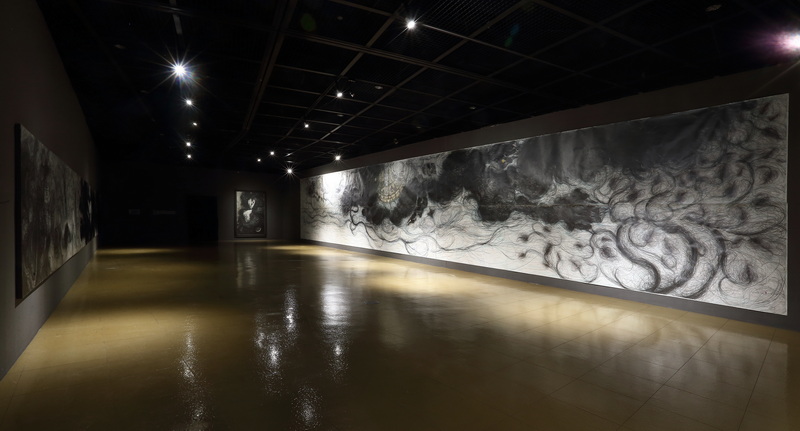
Park Sobin: I started painting self-portraits when I graduated from Gwangju Arts High School and attended Mokpo National University’s Department of Fine Arts. While preparing for the entrance examination to an art university in Seoul, Professor Won Dong-seok returned to the university after being reinstated as a dismissed professor. He was called the Father of Korea’s Minjung art in the 1980s and was a champion for democratization. Impressed by his first class, I wanted to look anew at my artwork and myself. So, I had my first solo exhibition with my self-portraits, which I was immersed in during my school days.
Art is said to be spoken in various languages, depending on the viewer, but my self-portraits are my view of my art in my 20s, when I was intensely concerned about human instincts and nature. They expressed the power of love to blossom new lives in the midst of the fear of people who could not be free from the pain of those times. The theme of my works was then about the myth of love that provides the energy that humans have been pursuing.
Jennis: Most students of colleges of fine arts make their debut with a group graduation exhibition. But as a student, you had a solo exhibition of nude self-portraits. I sense your tremendous energy as an artist. Since when have you worked on The Dragon and the Lady series with pencils? It’s an extraordinary transformation from oil painting to pencil drawings.

Park Sobin: There’s a beauty of moderation in the Oriental aesthetic point of view. As I tried to find the essence of my drawings while studying Oriental philosophy, I thought I didn’t have to use various colors. I think I was able to have a freer imagination by working with a simple material, the pencil. And the graphite, which is used as the core of a pencil, has the history of being underground for thousands and thousands of years. I wanted to use the time of origin of the pencil graphite to express the myth of the dragon that has been handed down for a thousand years in Korea. One day when I went to a temple on a fieldtrip, I saw a drawing of a dragon climbing a pillar. After feeling the powerful strength of life from the dragon pillar, I have deeply studied the myth of the great Buddhist monk Uisang (의상대사, 625–702), the Chinese lady Seonmyo (선묘), and the dragon.
More than 1,000 years ago, a great monk named Uisang from the Silla Dynasty went to China to study Hwa-eom-jong (화엄종), a doctrine of Buddhism. When Uisang returned to Silla after 10 years of study, a Chinese lady named Seonmyo, who admired him, threw herself into the sea, saying that she would become a dragon to protect him. I wanted to express the story of the lady who appeared in the form of a dragon. The long, black and curved lines of pencils became waves on the sea between the two lands. When the pencil lines overlapped as thick textures, the dragon and the lady became one.
Jennis: A few years ago, I read in several newspapers about your invitational exhibition at the main building of Today Art Museum in Beijing. And I heard that even Chinese artists are rarely receive invitations to exhibit in the main building of the museum. Would you please tell me about your exhibition at the Today Art Museum.
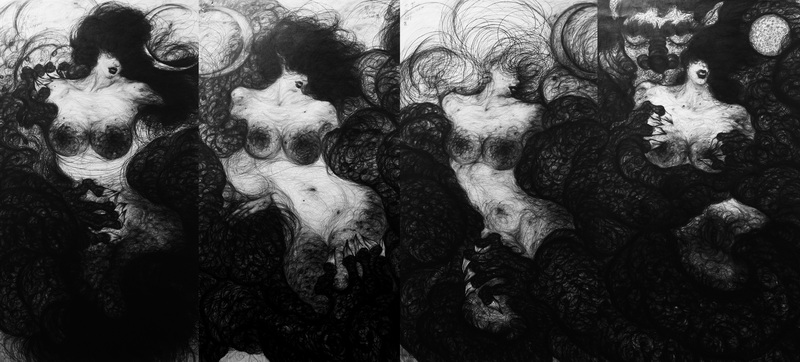
Park Sobin: It was in 2017, when I was offered an invitational exhibition at the main building of the Today Art Museum; it was the first time for a Korean artist to be invited. During the 49 days of the exhibition period, I filled a 3-meter-high and 17-meter-long wall with pencil drawings. I was immersed in my pencil drawing of the dragon goddess from morning to night. Not to break the mood of the story, I drew even while eating lunch from a packaged lunchbox in front of the painting. That’s why I sometimes met Seonmyo and the dragon even in my dreams.
Jennis: If it’s three meters high, you must have drawn at times on a ladder. What made you think of drawing a 17-meter-long painting with thin pencil lines all by yourself? I think it’s a historic event for an artist to draw for 49 days in an individual exhibition. Did the exhibition create any episodes for you?
Park Sobin: There were visitors who bought tickets every day and watched me work in the museum, and several 49-day videos of my work were produced by various media outlets. And it was nice to meet my friends who came from many other countries to celebrate my exhibition. [For one documentary video of the 49-day Beijing exhibition, go to https://www.youtube.com/watch?v=DpjOB0v4X1c]
Jennis: I wonder how you became such a world-class artist.
Park Sobin: There were some people who noticed my unique way of expressing Oriental mythology using the 20th century analog material called a pencil. When I was working as a resident artist at the Gwangju Museum of Art in 2005, Thalia Vrachopoulos, a New York art director who came to the Gwangju Biennale, stopped by my pavilion studio and was surprised to see my works on The Dragon and the Lady. She, as a person who majored in Oriental art history, said that she felt a unique originality from my work, which depicted with a pencil the Oriental myth of the dragon. What’s even more interesting is that before Thalia came to Korea, she saw my small art pieces in a group exhibition at the Elga Gallery in New York, and that interested her in my works. Luckily, I got offered an invitational exhibition from Elga Wimmer and Thalia Vrachopoulos at that time. Therefore, I started my overseas activities in earnest with my first individual invitational exhibition in New York in 2007.
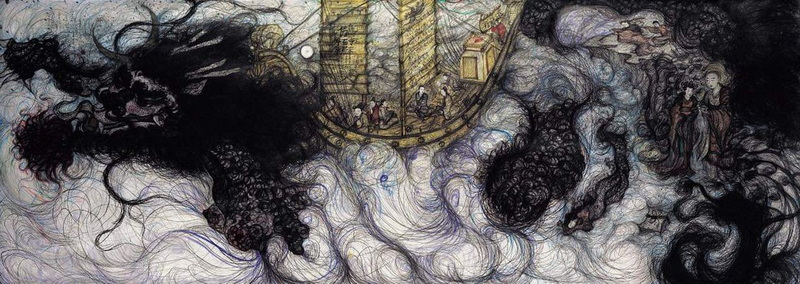
Jennis: Do you have any memorable episodes from your overseas exhibitions?
Park Sobin: Many people gave me encouragement and praise at the invitation of the Chelsea Art Museum in New York [in 2009], and I was especially happy when my story was featured in the 100-year-old world art magazine, Art in America [in May 2010], which I had subscribed to when I was in college.
Jennis: How did you get started in doing art in China?
Park Sobin: When I finished my residency at New York in 2009, Gwangju Museum of Arts recruited residency artists for the Beijing Creative Center. The Center, which just started in 2010, has been supporting artists in Gwangju to experience Chinese contemporary art and interact and work with artists from various countries around the world. However, the work of the Beijing Creative Center has been temporarily suspended since 2021 due to the recent COVID-19 pandemic. I went to the Beijing Creative Center in 2011. It has already been over 12 years since my first exhibition in China, followed by many other exhibitions in various countries.
Jennis: What are your plans for the future?
Park Sobin: Currently, I’m lecturing as an invited professor of fine arts at Hebei University. In addition, I’m preparing for exhibitions I have booked for the next two years. And at my studios in Beijing and in Gwangju, I continue working to find the origin of life.
After the Interview…
Looking at Park So-bin’s works in The Dragon and the Lady series makes me think of the word bul-i-mun (불이문). Among the several gates in a typical Korean temple, there is one gate named Bul-i-mun. Mun means “gate,” and bul-i means “not two.” It always makes me wonder why there couldn’t be two. Similarly, the dragon and the lady are not two different beings; I guess Park Sobin herself has also become the dragon, or the lady in the process of piling up those numerous pencil lines through which the two become one.
All myths are handed down from one generation to the next as memories, transforming themselves according to the needs of the times. I think Park Sobin’s myth also evolves with the times. And I hope that her artworks can soon be seen in an exhibition here, in her hometown of Gwangju.
Park Sobin
Born in Gwangju, South Korea, Park earned her BFA at Mokpo National University and her MFA at Chosun University. She has dedicated her life to art ever since her first solo exhibition in 1993. Park has exhibited globally and has developed her career as an international artist. She has enjoyed 15 solo and many group exhibitions, including in Gwangju, Seoul, Thessaloniki, and New York. In 2009, she was the recipient of the Young Artist Award from the Gwangju City Art Museum. She became an artist-in-residence in several programs: the Young Artist Residency program in Gwangju, the Gwangju City Museum Force Gallery residency, a residency in Beijing, and one at the Bushwick Open Studio in Brooklyn (2009) as well as at the Vermont Center for the Arts. For her Chelsea Museum show, she received recognition in the form of reviews in ARTnews and in Art in America as well as other prestigious publications. Her 2017 Today Art Museum exhibit in Beijing, her 2018 Sanhe Classic Car Museum Artspace Exhibit in Chengdu, her 2019 Laboratorium-Venezia exhibit, and her 2020 Elga Gallery exhibit in New York City resulted in several later museum shows in China and Korea. [See, for example, https://www.tusslemagazine.com/sobin-park]
The Interviewer
Jennis Kang has been living in Gwangju all her life. She has been doing oil painting for almost a decade, and she has learned that there are a lot of fabulous artists in this city of art. As a freelance interpreter, her desire is to introduce these wonderful artists to the world. Email: speer@naver.com





